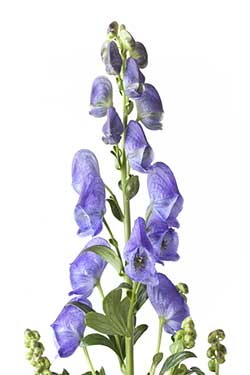Traditional/Ethnobotanical uses
Various species of Aconitum have been used for centuries both as poisons and medicines. The root is the most toxic plant part, although all parts are considered to be toxic. Extracts of Aconitum species have been given orally in traditional medicine to reduce fever associated with colds, pneumonia, laryngitis, croup, and asthma; for pain, inflammation, and high blood pressure; as a diuretic; to cause sweating; to slow heart rate; and for sedation. In traditional Asian medicine, root extracts are typically mixed with licorice or ginger. Extracts also have been used as arrow poisons. Historically, aconite was most commonly used in Western cultures as a tincture. It was applied topically as a counterirritant liniment for neuralgia, rheumatism, and sciatica. In homeopathy, aconite is used to treat fear, anxiety, and restlessness; acute sudden fever; symptoms from exposure to dry, cold weather or very hot weather; tingling, coldness, and numbness; influenza or colds with congestion; and heavy, pulsating headaches.
Recommended dosage
Extreme caution is required. Fresh aconite is extremely toxic, and safe dosage is dependent on processing. Many species are used medicinally in China only after processing. Traditional Western texts recommended 60 mg of the root per dose.



 Contact Us
Contact Us







 Hospitals
Hospitals
 Doctors
Doctors
 Diagnostic
Diagnostic
 Pharmacy
Pharmacy
 Health Tips
Health Tips
 Blog
Blog

















Comments